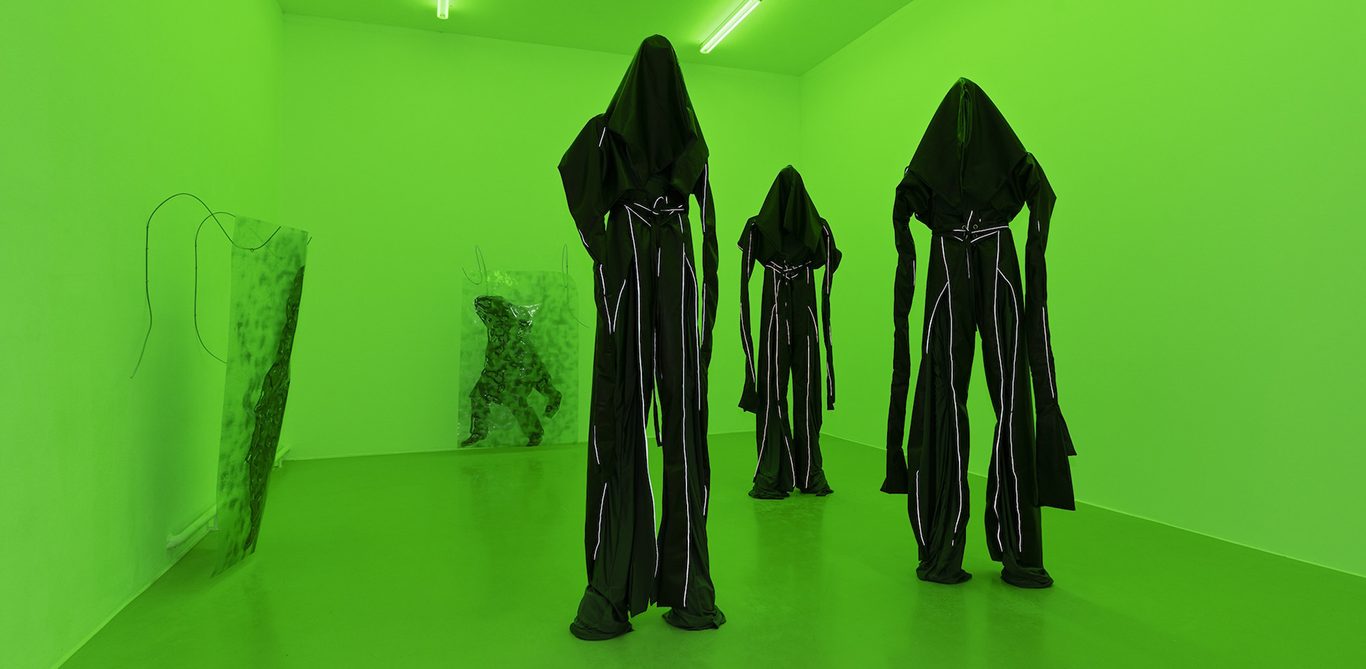As Germany reopens, an exhibition looking past the notion of a single ‘African diaspora’ is extended
In The Black Atlantic: Modernity and Double Consciousness (1995), Paul Gilroy describes ‘the Black Atlantic’ as a shared culture rooted in the convergence of cultures from Africa, the Americas, Britain and the Caribbean produced by the transatlantic slave trade. Twenty-five years later, Beyond the Black Atlantic seeks to expand and even redefine this shared culture in bringing together four young artists: Sandra Mujinga, Paulo Nazareth, Tschabalala Self and Kemang Wa Lehulere.
Gilroy’s book uses the ship as a recurring motif to focus on the Middle Passage and to act as a vessel of ideological and cultural exchange. Appropriately, then, this show opens with Wa Lehulere’s installation Matric 2015 (2018), with its glass bottles containing sand and scrolls of paper, guarded by porcelain dogs painted black. Wa Lehulere’s oeuvre often addresses the apartheid era, and these protected documents act as a reminder of inaccessible education. Here, however, the bottled messages – perhaps found floating, sunken or about to be cast out to sea – recall humans being forced through the Door of No Return, packed tightly into the hold and shipped from one place to the next as chattel.
In the following room the mood shifts to one of protection and fear. Under green light are three towering humanoid figures made of black faux-leather (Mujinga’s Camouflage Waves 1–3, 2018), hoods concealing where there should be faces, gangly fabric arms sagging past equally lanky legs and knees. This green light appears in another room, overtaken by Mujinga’s video installation Re-Imagining Things IV (2020). Two monitors – hung behind a curved black wall – display YouTube videos of fireworks altered with a liquid-effect filter and isolated in a green background. Here the green takes on new associations: rather than suggesting theatre or questioning whether the hooded figures are actually protecting themselves, it harkens to a filmic greenscreen as a place of alteration and transformation – a place where anything can be made manifest.
Digital manipulation and representation are again referenced in a room of Self’s textile assemblages and paintings. Her colourful, oversize portraits exaggerate women’s thighs and butts, and men’s phalluses and afros, pointing towards stereotypical media portrayals of black bodies. Self’s work gives way to Nazareth’s Anthropology of the Black II (2014), a film in which he lies on the ground at a museum for psychiatric patients in Salvador de Bahia and covers his head with skulls of the deceased. Elsewhere, 34 televisions host videos of waving flags, filmed by the artist during a two-year walk from Horizonte to New York City (Bandera Rotas (Broken Flags), 2014/2020). Placed on wooden pallets, the monitors are ready for immediate relocation, questioning the idea of a flag’s ‘fixed’ representation. Throughout their works, Self and Nazareth address the idea of malleable identities – in relation to nationalism, history and the current world order.
The breadth of positions here evidence the fact that black identities and communities cannot be summated by a singular term like the Black Atlantic; that there is no singular ‘African diaspora’. Diasporas are wide-ranging, from the Atlantic to the Mediterranean to the Indian Ocean to intra-Africa, so we should indeed be thinking beyond the Black Atlantic. The exhibition’s informational handout suggests one reason, among many, for this shift in understanding: ‘Social conflicts in Western societies that were long thought to have been overcome… have sparked new awareness among members of the Black community.’ But this begs the question, who has ever thought social issues like racism or inequality have been overcome? Perhaps this ‘new awareness’ results not from the realisation that such social issues continue to pervade everyday life, but rather from a global move towards an existence beyond the Black Atlantic – from finding seats at the table for everyone.
Beyond the Black Atlantic, Kunstverein Hannover, 15 February – 1 June
